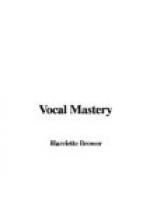“Sing that passage again; there is a tone in it that is not pleasant—not well-sounding; make it beautiful!” “Careful of your consonants there, they are not distinct; let them be clearer, but don’t make them over distinct.” “Don’t scoop up the ends of the phrases; make the tones this way”; and he illustrates repeatedly. “Sing this phrase in one breath if you can, if not, breathe here—” indicating the place.
The student now takes up an Italian aria. Of course the master teacher has no need of printed score; he knows the arias by heart. He merely jots down a few remarks on a slip of paper, to be referred to later.
The aria goes quite well. At its close the singer goes to her seat and another takes her place. A voice of rich, warm timbre. More English—and it must be most exact, to suit Mr. Bispham’s fastidious ear.
“Make the word fire in one syllable, not two. Do not open the mouth quite so wide on the word desire, for, by doing so you lose the balance and the tone is not so good.”
VOCALIZES
Another student—with a fine tenor—was asked to vocalize for a number of minutes. He sang ascending and descending tone-figures, sometimes doing them in one breath, at others taking a fresh breath at top. Some of the syllables used were: la, ma, may, and mi. He then sang single tones, swelling and diminishing each. It was found that passing from forte to piano was much more difficult than swelling from soft to loud.
The aria “Be not afraid,” was now taken up; it was pronounced one of the most difficult solos ever written, and a very valuable composition for vocal training.
“You sing that phrase too loud,” cautioned the instructor. “This is not a human being who is speaking, rather it is a heavenly voice. That high note of the phrase should be made softer, more ethereal. Make it a young tone—put the quality of Spring into it. The whole thing should be more spiritual or spiritualized. Now go through it again from beginning to end.”
When this was finished a halt was called; there had been enough work done for that day. Soon the class was dismissed. The young singers—some if not all of them known upon the concert stage—filed out. One young woman remained; she was to have a drama lesson. The master of singing showed himself equally efficient as master of English diction for the spoken drama.
And here, for a time, we must leave him at his work.
XXIII
OSCAR SAENGER
USE OF RECORDS IN VOCAL STUDY
Mr. Oscar Saenger has been termed “maker of artists,” since a number of our great singers have come from under his capable hands. He has a rare gift for imparting instruction in a way that is concise and convincing. A man of wide experience, profound knowledge of his subject, commanding personality and winning courtesy, he impresses all who come within his radius that he knows whereof he speaks. A man who “knows what he knows” is one to be followed.




